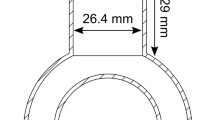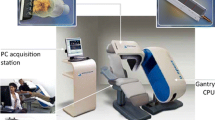Abstract
The purpose of this study is to investigate the feasibility of cardiac evaluation with a dynamic flat-panel detector (FPD), based on changes in pixel values during cardiac pumping. To investigate the feasibility of cardiac evaluation with a dynamic flat-panel detector (FPD), based on changes in pixel values during cardiac pumping. Sequential radiographs of a cardiac motion phantom and water-equivalent material step were obtained with an FPD system. Various combinations of cardiac output and heart rate were evaluated with and without contrast medium. The ventricular area and summation of pixel values in the ventricles were measured. The ejection fraction (EF) was calculated based on the rate of changes and then compared to EF obtained from computed tomography images. In addition, slight changes in pixel values were visualized by use of inter-frame subtraction and color-mapping. The result of a clinical case was examined according to cardiac physiology. There were strong correlations between EF and our results. There was no significant difference between the findings with and without contrast medium. When the heart rate was greater than 60 bpm, EF obtained with our method were underestimated. It is necessary for a patient to be examined at an imaging rate between 7.5 and 10 fps at least. In addition, a ±1.2% change in pixel value was equivalent to a ±10 mm change in the thickness of water. Color-mapping images were supported by cardiac physiology. Evaluating changes in pixel values on dynamic chest radiography with FPD has the potential to demonstrate cardiac function without contrast medium. Inter-frame subtraction and color-mapping are very useful for interpreting changes in pixel value as velocities of blood flow.






Similar content being viewed by others
References
Heyneman LE. The chest radiograph: Reflections on cardiac physiology. Radiological society of North America. Scientific assembly and annual meeting program 2005. 2005;45.
Felson B. Chest roentgenology. London: WB Saunders; 1973
Goodman LR. Felson’s principles of chest roentgenology, a programmed text. London: WB Saunders; 2006
Squire LF, Novelline RA. Fundamentals of radiology. London: Harvard University Press; 1988
Turner AF, Lau FY, Jacobson G. A method for the estimation of pulmonary venous and arterial pressures from the routine chest roentgenogram. Am J Roentgenol Radium Ther Nucl Med. 1972;116:97–106.
Chang CH. The normal roentgenographic measurement of the right descending pulmonary artery in 1,085 cases. Am J Roentgenol Radium Ther Nucl Med. 1962;87:929–35.
Pistolesi M, Milne EN, Miniati M, Giuntini C. The vascular pedicle of the heart, the vena azygos. Part II: acquired heart disease. Radiology. 1984;152:9–17.
Silverman NR. Clinical video-densitometry. Pulmonary ventilation analysis. Radiology. 1972;103:263–5.
Silverman NR, Intaglietta M, Simon AL, Tompkins WR. Determination of pulmonary pulsatile perfusion by fluoroscopic videodensitometry. J Appl Physiol. 1972;33:147–9.
Silverman NR, Intaglietta M, Tompkins WR. Pulmonary ventilation and perfusion during graded pulmonary arterial occlusion. J Appl Physiol. 1973;34:726–31.
Fujita H, Doi K, MacMahon H, Kume Y, Giger ML, Hoffmann KR et al. Basic imaging properties of a large image intensifier-TV digital chest radiographic system. Invest Radiol. 1987;22:328–35.
Vano E, Geiger B, Schreiner A, Back C, Beissel J. Dynamic flat panel detector versus image intensifier in cardiac imaging: dose and image quality. Phys Med Biol. 2005;50:5731–42.
Ning R, Chen B, Yu R, Conover D, Tang X, Ning Y. Flat panel detector-based cone-beam volume CT angiography imaging: system evaluation. IEEE Trans Med Imaging. 2000;19:949–63.
Akpek S, Brunner T, Benndorf G, Strother C. Three-dimensional imaging and cone beam volume CT in C-arm angiography with flat panel detector. Diagn Interv Radiol. 2005;11:10–3.
Endo M, Tsunoo T, Kandatsu S, Tanada S, Aradate H, Saito Y. Four-dimensional computed tomography (4D CT)—concepts and preliminary development. Radiat Med. 2003;21:17–22.
Mori S, Endo M, Tsunoo T, Kandatsu S, Tanada S, Aradate H, et al. Physical performance evaluation of a 256-slice CT-scanner for four-dimensional imaging. Med Phys. 2004;31:1348–56.
Tanaka R, Sanada S, Suzuki M, Kobayashi T, Matsui T, Inoue H, et al. Breathing chest radiography using a dynamic flat-panel detector combined with computer analysis. Med Phys. 2004;31:2254–62.
Tanaka R, Sanada S, Okazaki N, Kobayashi T, Fujimura M, Yasui M, et al. Evaluation of pulmonary function using breathing chest radiography with a dynamic flat panel detector: primary results in pulmonary diseases. Invest Radiol. 2006;41:735–45.
International basic safety standards for protection aginst ionizing radiation and for the safety of radiation sources. Vienna: International atomic energy agency (IAEA); 1996.
Hansen JT, Koeppen BM. Cardiovascular physiology. In: Netter’s atlas of human physiology (Netter Basic Science). Teterboro: Icon Learning Systems; 2002.
Tsujioka K, Uebayashi Y, Anzui M, Emoto S, Ohkubo Y, Takagi T. Heartbeat-operating phantom designed for CT scanning and nuclear medicine examinations. ECR 2006, Book of Abstracts, 2006;17 Suppl 1:231.
Xu XW, Doi K. Image feature analysis for computer-aided diagnosis: accurate determination of ribcage boundary in chest radiographs. Med Phys. 1995;22:617–26.
Li L, Zheng Y, Kallergi M, Clark RA. Improved method for automatic identification of lung regions on chest radiographs. Acad Radiol. 2001;8:629–38.
Acknowledgments
This work was supported in part by the Nakashima Foundation, Japan Science and Technology Agency, and a Grant-in-Aid for Scientific Research from the Japanese Ministry of Education, Culture, Sports, Science, and Technology: Intelligent Assistance in Diagnosis of Multi-dimensional Medical Images. The authors thank Yoshinori Uebayashi, Takahiro Gotou, Toshinori Sekitani, and Kazushige Asano at the Department of Radiological Technology, School of Health Sciences, Fujita Health University, who assisted in the phantom study, and Kazuya Nakayama, PhD, Department of Radiological Technology, Kanazawa University, and Norio Hayashi and the technologists of the Department of Radiology, Kanazawa University Hospital, who assisted with data acquisition.
Author information
Authors and Affiliations
Corresponding author
About this article
Cite this article
Tanaka, R., Sanada, S., Tsujioka, K. et al. Development of a cardiac evaluation method using a dynamic flat-panel detector (FPD) system: a feasibility study using a cardiac motion phantom . Radiol Phys Technol 1, 27–32 (2008). https://doi.org/10.1007/s12194-007-0003-0
Received:
Revised:
Accepted:
Published:
Issue Date:
DOI: https://doi.org/10.1007/s12194-007-0003-0




